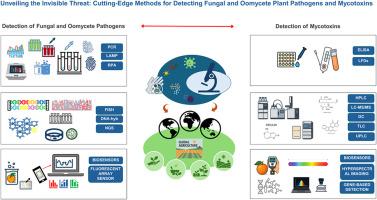揭示无形的威胁:检测真菌和卵霉菌植物病原体和真菌毒素的尖端方法
IF 3.3
3区 农林科学
Q2 PLANT SCIENCES
引用次数: 0
摘要
早期发现真菌和卵霉菌病原体以及准确监测真菌毒素对于确保食品安全和维持农业生产力至关重要。这篇综述提供了当前诊断工具的关键概述,包括传统的形态学评估,血清学分析和先进的分子方法,如PCR变异,等温扩增(LAMP, RPA), DNA杂交和下一代测序。还描述了真菌毒素检测的分析策略,包括基于溶剂的提取,免疫测定,液相色谱与质谱联用,以及新兴的生物传感器技术。本综述的一个独特贡献是基于共同的性能标准敏感性、特异性、周转时间、现场适用性和成本对这些方法进行了比较评估,为植物检疫环境下的方法选择提供了一个横向框架。特别关注影响柑橘供应链的检疫病原体和产霉菌毒素真菌,在这方面,早期和准确的诊断对于防止产量损失和贸易限制至关重要。该综述强调,方法的选择应以具体的诊断目标、可用资源和监管要求为指导,综合战略通常是确保食品安全和植物检疫安全的最实际解决方案。本文章由计算机程序翻译,如有差异,请以英文原文为准。

Unveiling the invisible threat: cutting-edge methods for detecting fungal and oomycete plant pathogens and mycotoxins
Early detection of fungal and oomycete pathogens and accurate monitoring of mycotoxins are critical for ensuring food safety and sustaining agricultural productivity. This review provides a critical overview of current diagnostic tools, covering traditional morphological assessments, serological assays, and advanced molecular approaches such as PCR variants, isothermal amplification (LAMP, RPA), DNA hybridization, and next-generation sequencing. Analytical strategies for mycotoxin detection are also described, including solvent-based extraction, immunoassays, and liquid chromatography coupled with mass spectrometry, alongside emerging biosensor technologies. A distinctive contribution of this review is in the comparative assessment of these methodologies based on shared performance criteria sensitivity, specificity, turnaround time, field applicability, and cost, offering a transversal framework for method selection across phytosanitary contexts. Special attention is given to quarantine pathogens and mycotoxigenic fungi affecting the citrus supply chain, where early and accurate diagnosis is pivotal to prevent yield losses and trade restrictions. The review highlights that method selection should be guided by the specific diagnostic objective, available resources, and regulatory requirements, with integrated strategies often representing the most practical solution to ensure both food safety and phytosanitary security.
求助全文
通过发布文献求助,成功后即可免费获取论文全文。
去求助
来源期刊
CiteScore
4.30
自引率
7.40%
发文量
130
审稿时长
38 days
期刊介绍:
Physiological and Molecular Plant Pathology provides an International forum for original research papers, reviews, and commentaries on all aspects of the molecular biology, biochemistry, physiology, histology and cytology, genetics and evolution of plant-microbe interactions.
Papers on all kinds of infective pathogen, including viruses, prokaryotes, fungi, and nematodes, as well as mutualistic organisms such as Rhizobium and mycorrhyzal fungi, are acceptable as long as they have a bearing on the interaction between pathogen and plant.

 求助内容:
求助内容: 应助结果提醒方式:
应助结果提醒方式:


